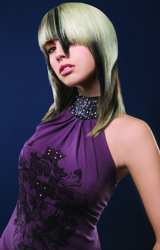Persianista has this spot on.
For what it's worth I teach the VRQ Level 4 Advanced Hair Colour Theory Courses too.
A few points were raised in this thread that I hope I can help with:
1.
Why would you need a level 9 tint with anything except violet if the underlying pigment will always be gold? Because hair colour is individual - your aim is not to make everyone a 'flat level 9', but to decide if you'd like to enhance or neutralise the NRP (natural remaining pigment). If you want to enhance the NRP at level 9 (which is yellow) you can choose level 9 colours with gold tones or copper tones (such as 9.3). If you want to neutralise you would choose level 9 with violet. If you want to cool it down you would choose level 9 with ash.
2.
Why do I need a highlift tint with ash to prevent my level 6 hair looking brassy - when I use violet it is still warm? Because highlift tint is not like bleach - it doesn't keep lifting the longer and longer you leave it on. Highlift tint might claim to lift upto 4 levels, but that doesn't mean 4 levels on everyone's hair type - you need to think about your hair-type, texture and tenacity when colouring and not just NRP.
Level 6 hair that is poker straight, thick and tenacious will be more difficult to lift than wavy, very fine hair purely due to the amount of product required to get through the cuticle and saturate the cortex. After 45 minutes on the more tenacious hair you would probably find that the hair has lifted only 2 true levels (leaving behind a yellow orange NRP). On the fine hair you will find it has lifted 4 levels (leaving behind a pale yellow NRP).
When we bleach hair we take this for granted - checking every 10 minutes. A highlift tint is basically a bleach with toner built in. Also, remember that placing highlift tint under heat opens the cuticle (allowing faster lightening) but also makes the colour formula more acidic (making it harder to tone successfully after the lift is achieved) - so sometimes, patience is key.
3.
Why do they have green tones is the likes of Spectrum/Graphics etc? Similar reasons to the above really. Graphics is advertised as lifting through to blonde in just 12 minutes under heat. In reality it lifts as much as it can in 12 minutes and relies on you choosing the right pigment to "correct whatever is left". On level 5 tenacious hair Graphics lifts to anywhere between a 7 and 8 in 12 minutes. The NRP is orange towards orange/yellow.
That's why you would use - GREEN - for the best results.
WTF? Did he just say GREEN? Why not 'blue' or even 'blue and violet'?
LOL.
Sorry to confuse you. Think about what colours make up green - blue and yellow right?
OK, so the Graphics has lifted all of the hair strand to somewhere between a level 7 and level 8 (i.e. orange and orangey yellow) - but it's not even though. The ends might be a level 7 (orange, maybe even a little bit orangey red in places) and other areas might be an orangey yellow (just like when you bleach hair in one go).
Where the hair is orange, it will absorb the blue pigment from the green toner, leaving behind the gold reflect - hence making a 7.03 (rather than a flat 7.0). Where the hair is orange/yellow it will absorb less of the blue pigment from the green toner, leaving just enough behind to slightly cool the yellow pigment, thus making a 7.03 result on the midlengths too.
This is why if you look at a Graphics shade chart all of the "green" examples look like a golden result when used on level 5 hair.
If you had used the blue pigment on level 5 instead of the green you would have ended up with an uneven result (roots looking lighter than the ends).
Hope the above clears things up and helped to answer some of the questions raised.








